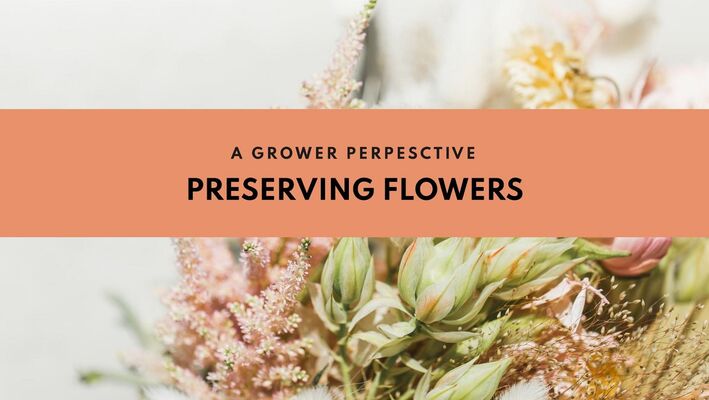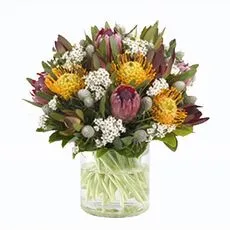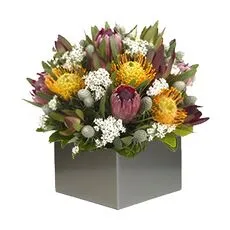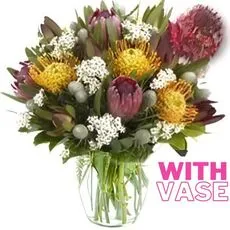Flower Preservation Techniques

Preserving flowers is an age-old practice that has blossomed into a modern art and science. No longer limited to pressing petals in books, today’s flower preservation industry uses high-tech methods to turn fleeting blooms into lasting mementos. This niche is growing steadily – the global preserved flowers market was valued around USD 180 million in 2023 and is projected to reach roughly USD 272 million by 2032, at an annual growth rate of about 4.8%. By comparison, the cut flower market (fresh flowers) is a multibillion-dollar giant (about USD 21.8 billion in 2024), yet preserved florals are gaining ground as consumers seek more value and longevity from their bouquets.
In Australia, where flower retailing generates approximately AUD 1.1 billion in revenue for 2023–24, a growing segment of florists now offer preservation services alongside fresh arrangements. This article, by the team and myself at Lily's Florist Australia, explores how modern techniques – from freeze-drying to resin casting – are revolutionising flower preservation, driven by demand for sustainable keepsakes and new business opportunities in Australia and beyond.

The Demand to Make Flowers Last
Flowers mark our most meaningful moments – weddings, anniversaries, memorials – but their beauty is ephemeral. It’s no surprise many people now look to preserve bouquets as cherished keepsakes. For instance, Australia saw 127,161 marriages in 2022, the highest on record, each typically adorned with floral bouquets that often end up wilted in the bin days later. With couples spending an average of AUD $1,678 on wedding flowers (up 12.5% from previous years), there’s strong motivation to prolong the life of those blooms. About 74% of Australian couples choose real flowers over faux for their weddings, showing a clear preference for natural bouquets – and a desire to hold onto those real flowers’ beauty after the day.
Preservation offers a solution: rather than tossing bouquets, brides and grooms can display them at home for years. This trend isn’t limited to weddings. Memorial flowers from funerals or commemorative events are also often preserved by loved ones, and anniversary bouquets can be turned into lasting pieces of art.
While hard numbers on bouquet preservation are emerging, social media interest hints at its popularity. One viral TikTok video about saving a boyfriend’s bouquet garnered 10.8 million views, indicating a broad audience curious about keeping flowers alive (in some form) well beyond their natural lifespan. Over on Instagram, the hashtag #driedflowers has more than 3.8 million posts featuring dried and preserved floral décor, from bridal bouquet displays to DIY projects.
Florists confirm the shift: during the pandemic when fresh flower imports became uncertain, one Australian wholesaler saw flower demand surge by 50% even as supply struggled. Many customers turned to longer-lasting dried and preserved arrangements as a creative, sustainable alternative. Clearly, the public appetite to save their blooms – and the memories attached to them – is on the rise.
Innovations in Flower Preservation Techniques
Modern flower preservation goes far beyond hanging roses upside-down in a closet. A range of innovative techniques and technologies is now used to capture flowers at their peak and make them last for years. Here are some of the cutting-edge methods transforming the field:
Freeze-Drying
This high-tech process freezes flowers and then gently removes moisture in a vacuum chamber. The result is remarkably lifelike: freeze-dried blooms retain their original shape and colour almost perfectly. With proper care, freeze-dried flowers can last 5–10 years before showing significant fading. (In contrast, traditional air-dried flowers might only last 1–2 years.) Freeze-drying does require specialized equipment and skilled handling – flowers are frozen at ultra-low temperatures and dried over days or weeks – but it’s become a gold standard for preserving bridal bouquets and other valued florals. In fact, food dehydrators have even become popular for small-scale flower preservation, offering controlled temperature and humidity to prevent petals from browning. The investment pays off in longevity: a bride can glance at her freeze-dried bouquet on her anniversary ten years later and see the same blossoms from her wedding day, beautifully intact.

Silica Gel Drying
Silica gel, those little beads often found in packaging, is a desiccant that can dry out flowers while locking in their form and hue. Florists bury fresh blooms in silica gel crystals; within days, the gel absorbs moisture from the petals. The flowers emerge dried but with petals largely preserved in colour and shape. Silica-preserved flowers typically last around 5 years if kept safe from humidity. This method is popular for do-it-yourself preservation – kits are readily available, allowing anyone to preserve a graduation corsage or Valentine’s roses at home. It’s eco-friendly too, as the silica gel can be reused many times. However, silica-dried flowers are brittle, so they’re often later sealed or framed to protect them from damage.

Resin Casting
Perhaps the most visually striking trend in modern preservation is encasing flowers in clear epoxy resin. Artisans arrange dried blooms (often first preserved via silica gel or freeze-drying) in moulds and pour epoxy resin, which hardens into a crystal-clear block that suspends the flowers inside. The result is part sculpture, part time-capsule – a rose frozen in an acrylic-like paperweight, or an entire bridal bouquet displayed in a glossy resin panel.

Flowers preserved in resin can effectively last indefinitely (a lifetime with proper care), since the resin protects them completely from air and moisture. This technique has opened up creative possibilities: jewellery like pendants and rings filled with tiny blooms, coasters and tabletops with floral inlays, even resin memorials that incorporate flowers with ashes. Specialized studios have emerged worldwide – in Hawaii, FloFlo Flowery pioneered resin wedding bouquet art, and similar studios are popping up in Australia, offering newlyweds everything from resin hexagon displays to floral keepsake coasters. It’s a labour-intensive process (casting without trapping air bubbles or discolouring the petals takes skill), but the payoff is a one-of-a-kind piece of art that preserves the vibrancy of fresh flowers forever.
Example of a preserved bouquet cast into a resin block – these roses and baby’s breath will remain as vibrant keepsakes instead of wilting.
Pressing and 3D Preservation
Pressing flowers is a traditional technique (flattening blooms between absorbent paper) that is still very much alive today, often combined with modern twists. Couples might have their wedding flowers pressed and framed in a beautiful shadow box, creating wall art from their bouquet. Technology has enhanced this art – there are even microwave flower presses and 3D-printed presses that cut drying time from weeks to minutes. Pressed flowers can last for decades when framed, though they lose their three-dimensional shape.

This is where 3D printing steps in as a futuristic complement: some designers are now using 3D scanning and printing to create artificial replicas of flowers or intricate holders for preserved blooms. For example, a delicate orchid can be 3D-scanned and reprinted in resin or biodegradable plastic to reconstruct its exact form, or a custom vase insert can be 3D printed to hold each preserved flower in the same arrangement as the original bouquet. These innovations blur the line between natural and artificial – mixing real preserved petals with 3D-printed stems or supports – opening up new possibilities to display flowers in creative ways.
Keeping Flowers Green (and Going Green)
Beyond sentimentality, a major driver of modern flower preservation is sustainability. Preserving flowers can reduce waste and give blooms a second life, aligning with the eco-conscious values of many consumers today. Consider that the average wedding celebration produces about 400 lbs of waste (over 180 kg) and 63 tonnes of CO₂ emissions – and a portion of that footprint comes from floral décor that’s used for a few hours and then discarded. Huge volumes of cut flowers end up in landfills; indeed, during the height of pandemic disruptions, an estimated 1,500 tonnes of fresh flowers were being dumped every week overseas due to oversupply and shipping issues.
In this context, the appeal of everlasting flowers becomes clear. A preserved bouquet or arrangement doesn’t get tossed out; it becomes home décor instead of garbage. As one industry report noted, dried flowers are gaining popularity among wedding planners specifically because they don’t need to be thrown out after the event – they can be reused or kept, making the celebration more environmentally friendly. Couples can even hand out dried floral centrepieces to guests to take home, extending the blooms’ life and reducing waste.
The flower industry is also responding to calls for greener practices. Florists are increasingly adopting eco-friendly preservation methods, such as using non-toxic, biodegradable preserving solutions and avoiding chemical-laden foam in arrangements. Sustainable floristry is a rising movement: in one U.S. study, 58.4% of consumers agreed that buying from an environmentally friendly florist is “the right choice,” even if it costs a bit more. And many are indeed willing to pay more – over 60% of floral customers said they would pay at least 10% extra for sustainably sourced or locally grown flowers. Specifically, 61.7% are willing to pay 10% more for locally grown blooms and 59.5% would pay 10% more to patronise florists who compost their flower waste. Around 31% even said they’d pay a 15% premium for those eco-friendly practices. This is a powerful signal that people value sustainability in their floral purchases.
Preservation techniques dovetail nicely with these concerns. Dried and preserved flowers are often sourced locally and seasonally (since they can be prepared when flowers are abundant and stored year-round), cutting down on the need for energy-intensive imports. They also last far longer in the home, reducing the frequency of buying new imported fresh flowers that come with a high carbon footprint from refrigeration and air freight.
Some preservation businesses are emphasising natural, green methods – for example, using organic glycerine to preserve greenery, or developing plant-based resins and solvents that are kinder to the environment. Composting is also easier when flowers haven’t been treated with harsh chemicals; any offcuts or unused portions can return to the earth rather than sit in a landfill.
In Australia, florists have noted a shift in customer preferences post-pandemic: more people ask for locally grown blooms and sustainable options. (It’s estimated about 40% of cut flowers in Australia are imported in normal times, so there’s big room to grow the local share.) The good news is that sustainability and preservation go hand in hand – for instance, the Slow Flowers movement, which champions local and seasonal flowers, often encourages drying or preserving surplus blooms to minimise waste. By keeping flowers out of the rubbish bin and in our lives longer, modern preservation is helping floristry turn over a new leaf on sustainability.
Market Trends and Business Opportunities
What was once a cottage craft has become a blossoming business sector. The rising demand for preserved flowers – for all the reasons above – is translating into significant market growth and entrepreneurial opportunity. Globally, preserved and dried flowers are carving out a larger slice of the floral industry pie each year. The global preserved fresh flower market (which includes anything from glycerine-preserved “forever roses” to freeze-dried blooms) grew from about USD 213 million in 2023 to USD 223.8 million in 2024, and is forecast to reach ~USD 305 million by 2030. Similarly, the global dried flowers market (overlapping but broader, often used for potpourri, crafts, and décor) is projected to climb from USD 386 million in 2024 to roughly USD 683 million by 2034, at a healthy ~5.9% CAGR. These numbers, while modest next to fresh flower sales, show that preserved florals are no longer a fringe trend – they’re a stable and growing industry.
Industry analysts attribute this growth to the wedding sector and home décor trends: in fact, weddings and event decoration make up the largest application segment of the preserved flower market through 2028. Consumers have embraced the idea of displaying long-lasting floral pieces in their homes, and gifting preserved flower arrangements (which last far longer than a fresh bouquet) has become popular for holidays and special occasions.
This market momentum is evident in Australia as well. Many local florists and artisans have added preservation to their services, from bouquet-freezing to resin art, creating new revenue streams beyond fresh flower sales. Australia’s floral retail industry remains fragmented with around 2,000 florists nationally (over a third of them in NSW), and those who diversify with unique offerings can stand out. Selling a pressed flower artwork or a resin keepsake alongside a bouquet allows florists to upsell and engage customers looking for meaningful purchases.
In 2023–24, dried flowers and related giftware accounted for an estimated 9% of Australian flower retail revenue (about AUD $99 million), a share that is expected to rise as preserved arrangements become more mainstream. Some entrepreneurs have even launched dedicated preservation businesses – for example, specializing only in bridal bouquet preservation or funeral flower keepsakes – tapping into the emotional value of flowers. The number of start-ups selling preserved flower products (like floral jewellery, artwork, and DIY kits) is increasing worldwide, reflecting creative new angles on this business.
Social media and online platforms have been key to this rise. Bespoke preservation artists often showcase their work on Instagram or TikTok, where a single viral post can bring inquiries from around the globe. A quick search of #bridalbouquetpreservation yields countless before-and-after photos that entice new brides to preserve their own. E-commerce has broadened access too – preserved flowers can be shipped without the urgent overnight timelines fresh flowers need, so businesses can serve wider regions.
North America currently leads the preserved flower market (holding about 38% of global market share in 2023), but Asia-Pacific is the fastest-growing region for these products, with many innovations coming out of Japan and China (such as the development of vibrant preserved moss wall art and “eternal roses” in decorative glass domes). This international growth is feeding a virtuous cycle: greater awareness, more demand, and in turn more businesses innovating to supply that demand.
For those in the floral trade – whether wedding planners, florists, or crafty hobbyists turned entrepreneurs – modern flower preservation opens up new revenue streams and creative services. Preserved arrangements can command premium prices due to the labour and skill involved, and customers are willing to pay for the artistry and longevity. Market researchers forecast the preserved flower sector to keep growing ~5% per year through the rest of the decade, which means opportunities will continue to bloom. From selling DIY preservation kits, to offering subscription services for memorial flower preservation, to innovating new biotech methods for even longer-lasting blooms, the possibilities are blooming. And importantly, this business growth is underpinned by positive environmental impacts and customer joy – a rare win-win where making profit and saving petals go hand in hand.
Conclusion
Modern flower preservation beautifully intertwines innovation with sentiment. On one hand, it’s driven by cutting-edge technology – vacuum freeze-dry chambers, specialized polymers, even 3D-printed accessories – that push the boundaries of how long and in what form we can enjoy nature’s floral gifts. On the other hand, it speaks to a timeless human desire to hold onto moments and memories, whether it’s a bride freezing her bouquet from the big day, or a family encasing a loved one’s memorial roses in a lasting tribute.
The trends outlined – from the surge in resin art keepsakes to the embrace of eco-friendly dried arrangements – show that flower preservation has evolved from a quirky craft into a vibrant sector meeting diverse needs. It caters to florists seeking sustainable practices, consumers craving more value and personalization, and businesses looking to differentiate with creative offerings.
In Australia and around the world, florists and preservation artists are collaborating, with traditional skills and new tech working in harmony. A decade ago, few could have imagined wedding flowers being turned into coasters or lamps, or dried bouquets becoming high-fashion décor; now these are readily available services, often booked out for months. The movement also aligns with the push for sustainability in floristry – by extending the life of flowers, we honour the resources that went into growing them and reduce waste.
Looking ahead, expect to see even more innovation: perhaps smart preserved flowers that can change colour with LED lighting, or new organic preservation fluids that keep flowers flexible and soft to touch. The marriage of technology and nature is still in its early days in floristry.
I first published this article on 7.2.24. In that short time, the industry has moved on a lot! I decided to give the article a major refresh, like every word to bring it up to speed and published it again on 4.4.25.
Sources
Recent industry reports, Australian Bureau of Statistics data, and market research (2022–2025) have been used to inform this article’s statistics and findings. These sources include the Australian Bureau of Statistics, industry analyses (IBISWorld, Mordor Intelligence), floriculture sustainability studies, and global market forecasts for preserved and cut flowers. Each statistic is drawn from credible, up-to-date data to ensure accuracy in highlighting the modern trends in flower preservation.




